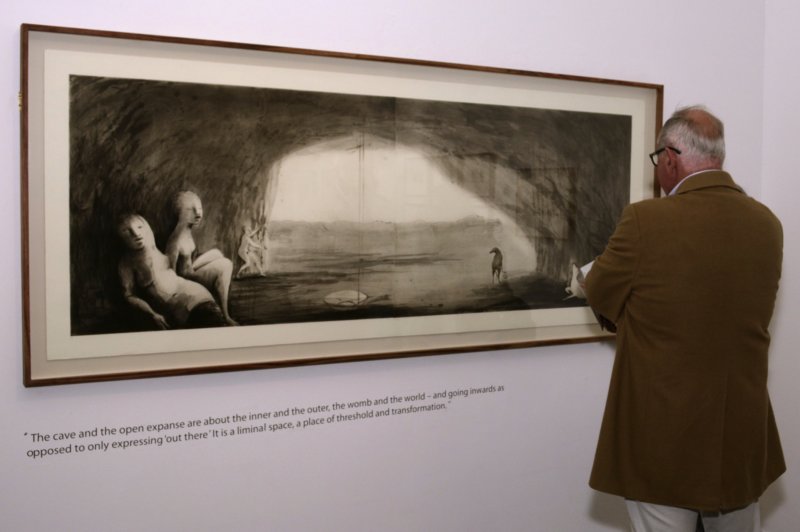During April to 8 May 2018 I visited 2 exhibitions by local artists.
Invocations to the Plate by Deborah Bell : 12 to 2 June 2018 at David Krut Projects, Parkwood, Gauteng.
Deborah Bell is one of South Africa’s most celebrated contemporary artists and works in a range of media on canvas and paper, produces dry point etchings and large-scale bronzes. Deborah Bell has worked with a great variety of media during her career and has collaborated on various historically important projects with contemporaries such as William Kentridge and the late Robert Hodgins. Bell received her BAFA (Hons) and MFA degrees at the University of Witwatersrand, and has been an artist working abroad and a lecturer at various South African tertiary institutions, including the University of the Witwatersrand. Bell lives and works from her studio in Magaliesburg, as well as being a collaborator at the David Krut studios on several projects. This exibition of prints was called, Invocation to the Plate. The largest work, Four- plate drypoint and spitbite aquatint was 180 x 464 cm. (photo underneath)

- My husband enjoying the work – She Wolf, 2017.
She also showed state proofs of the process up to the final print, and it was interesting to note that she changed the work during the process. She commented on this as part of her own transformation whilst doing art. I found her a very intuitive artist. She keeps notebooks and sketchbooks, and these were also part of the discussion. Bell’s initial ideas are often conceived form her visual notebooks. These books have quick, spontaneous gestural moments. The great part of this exhibition was that there was follow up sessions, one being a discussion between the artists and the printmakers, and another in the form of a demonstration on the technique of ‘chine colle’, which I could also attend. Whilst viewing these works I realise that the reflection the artist conveys makes me explore into more internal understandings of my own.

HARMONIA; Sacred Geometry, the pattern of existence by Gordon Froud, 13 April to 15 June 2018 at Standard Bank, Gallery, Gauteng.
Froud graduated with a BA(FA)Hons from the University of Witwatersrand in 1987, a Higher education Diploma from the same university in 1987 and a master’s degree in Sculpture from the University of Johannesburg in 2009 where he runs the Sculpture department as a senior lecturer. He has taught continuously at school and tertiary level in South Africa and in London since 1990.
The exhibition is made up of an extensive body of work, of over 100 pieces that ranges from small-scale crystal glass works to a monumental 6.5m high polyhedron made from 18 giant road cones. Froud finds sacred geometry in the landscape, the cityscape, in the human form and spirit, reinforcing the extent to which geometry is inherent in both our corporeal existence and the patterns of the universe.
Froud explores sacred geometry across many belief systems from ancient Egypt, the Maya, Judeo-Christianity and Islam, to contemporary belief in aliens; the inter-dimensionality of beings; the authenticity of crop circles and so forth. I loved the work done on brown paper – cityscapes as well as geometrical shapes.
VISIT TO JAG
During the first week end of May I visited the Johannesburg Art Gallery. The sad story here is that the building is in a very neglected state and in need of serious renovations and funding. Most of the older works I used to see in the gallery on previous visits has been removed and I really am concerned for their safety – the building has leaks, water damage and damp issues. One wonders if the air-conditioning system is up to scratch! It is a beautiful old building with a rich history of being gifted with great international works of art.
I decided to add this visit to my blog as I walked into two Odilon Redon prints – the markings are exquisite and who needs colour with such great mastery of tone?
LUNCHTIME LECTURE at Pretoria Arts Society : Wednesday 8 May 2018
Prof Alex Duffey discussed Las Minias by D Velazquez. This was his 6th lecture over his choice of the world’s 10 most famous artworks. He have detail of al 11 characters in the work and described it as most probably only a fleeting moment where Velazques captured the status of an artist in Spain, he puts himself in a physical en aristrocatic pose, but the composition is a pun: the viewer takes the place of the King Phillip 1V and Queen of Spain, whom Velazques was actually painting. It is also seen as that the artist did not paint what he saw, but what the King and Queen saw. This is a painting of a painting!
There was great discussion around how the artist used light to establish several focal points and how he understand tone by the use of dark, light and mid tones. The prof commented that this is Truth of Tone: tonal relations that are true . Light enters the room (his studio) from the Right (looking at the picture as viewer), he uses shadows to emphasise and put the little Infanta as the main focal point as well as the other focal points, such as the painter himself and the mirror reflection of the King and Queen.
Interesting is how many other artists ‘copies’ this composition. Apparently in the Prado Museum there are 58 interpretations by Picasso. I also know the paintings by Singer Sargent and Salvador Dali. In South Africa Deborah Bell extensively used this composition in here series, By What Light Do We Really See? (2012-2014)